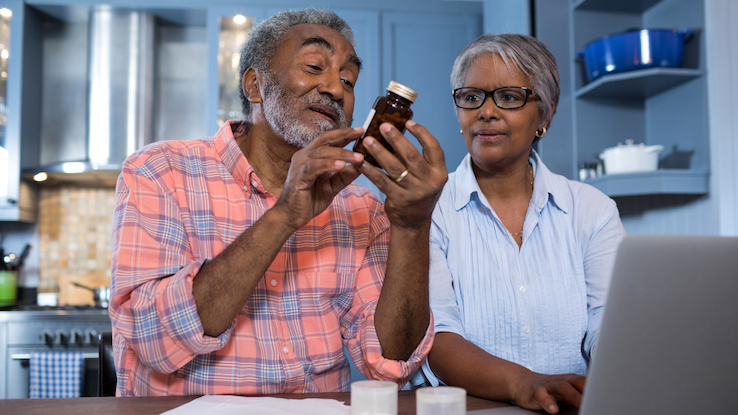
Keeping track of multiple medicines can be a challenge. If you accidentally spill your pill box or you find a pill that fell out of the bottle, you may need help figuring out which pill is which. Learn how to use online pill identifier tools to find your pills by picture or imprint code.
How to Identify Pills by Imprint Code or with Pictures
The U.S. Food and Drug Administration (FDA) requires all pills to look unique, so it’s easier to identify them. You can look for differences in color, shape and size, as well as unique patterns or markings. Besides a unique appearance, pills also have a unique code on one side, called an imprint code. Imprint codes may include numbers and letters or even the drug name or logo.
With an online pill identifier tool, you can use all this information to find an unknown pill. You simply type in the pill’s imprint code and select the color and shape. Then the tool searches a database of all FDA-approved pills — including prescription and over-the-counter, generic and brand-name pills.
Give it a try with these free online pill identifier tools:
- Pill Identification Wizard from Drugs.com
- Pill Identifier from Medscape.com
- Pill Identifier from Rxlist.com
What to Do If You Can’t Identify a Pill
If the tool shows no results, recheck the imprint code. Try using a magnifying glass to see very small or faint codes. If the imprint code is too hard to read, you can also search for the pill using just the shape and color. Then tool will show you pictures of all the different pills that fit the description.
If you still can’t identify the pill, it may not be an FDA-approved medicine. Pills that don’t show up in pill identifier tools may be counterfeit pills or illegal drugs, or they may be pills from a foreign country. It could also be a vitamin or supplement pill. Most vitamins and supplements are not FDA-approved, so they don’t have imprint codes and won’t show up in pill identifiers.
Talk with a pharmacist if you’re having trouble identifying a certain pill. And never take a pill if you’re not sure what it is. It’s always better to throw away an unknown pill than to take it.
How to Use Medicines Safely
When it comes to taking pills, it’s important to follow your doctor’s directions and the instructions on the label. If the directions are unclear or you have questions, check with your doctor or a pharmacist.
Take Medicines on Time
Follow these tips to make sure you’re taking your medicines on schedule:
- Use a pill organizer. Pill organizers, like medicine kits or pill boxes, are a great way to organize your pills by the day and time you take them. This way, you’ll also know if you forgot to take a certain pill.
- Find a schedule that works for you. Take medicines at times that coordinate with your daily routine. For example, it may be helpful to take medicines at meal times or right before bed so that it becomes part of your regular schedule.
- Set reminders or alarms. Remember to take your medicines at certain times by setting reminders in your phone, watch or alarm clock.
- Use a chart or calendar to log when you take your pills. With this method, you check off each dose and keep a record. This way you look back at the log to double check if you took a certain pill.
Be Open and Honest With Your Doctor
Many medicines can interact with other drugs or substances, so it’s important for you doctor to know about every medicine, vitamin or supplement you take.
Try keeping a list of everything you take, so you can easily share it with your doctor or pharmacist. And be honest with your doctor about any other substances you use, including alcohol, tobacco or any illegal drugs.
If you have problems or side effects from a medicine, tell your doctor. Your doctor may be able to switch you to another medicine. But always talk with your doctor before stopping a prescription drug.
Store and Dispose of Medicines Safely
It’s also important to store medicines correctly. Always store your medicines where children can’t get to them. Most medicines need to be stored in a cool, dry place, like a cabinet. But others may need to stay in the refrigerator. Read the labels to make sure you’re storing medicines in the right way, and check with a pharmacist if you have questions.
If you need to dispose of unused medicines, make sure to follow the instructions to get rid of them safely. For example, you can flush some types of pills down the toilet, but others need to go in the trash. Check the label for instructions — or use the FDA’s tips for disposing of medicines.
Find Info About Your Pills Online
If you need more information about any pills or medicines you’re taking, talking with a doctor or pharmacist is a good first step.
You can also check for drug information on MedlinePlus from the National Library of Medicine (NLM). And if you ever lose the pill bottle and need to find the label instructions online, try the NLM’s DailyMed database of package instructions for medicines.
Resource Links:
- “Safe Use of Medicines for Older Adults” via National Institute on Aging
- “Use Medicines Safely” via MyHealthfinder





